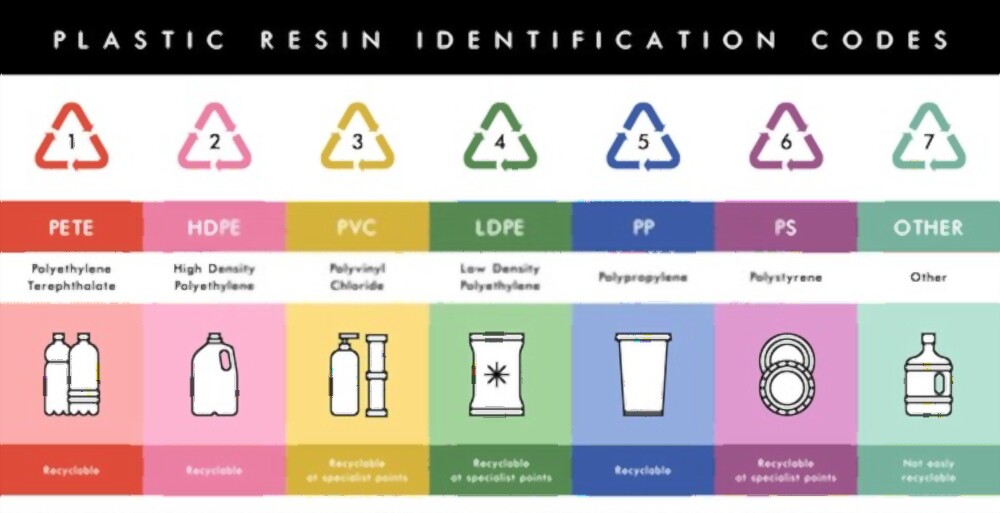
Have you ever looked at your plastic and noticed a triangle symbol with a number inside? Do you know what they mean? These are the plastic resin identification codes that was introduced in 1988 to help with its recycling.
Plastics are produced via chain-growth polymerisation from an unsaturated monomer. Typically these are simple molecular structures such as ethylene, propylene, vinyl chloride, styrene etc. There are literally hundreds of different types of plastic but only a handful that we encounter on a regular basis. Below is just a starting point to what is a huge topic but it will give you a huge insight to the complexity of recycling, upcycling and health risks associated with plastic.
1. Polyethylene Terephthalate (PET)
This is one of the most commonly used plastic. It is light, strong, usually transparent and is often used in food packaging and clothing (polyester). The amount of clothing made from this type of plastic is increasing and it is posing an invisible threat. Every time you wash your clothes microplastics break away and are released into the ecosystem. In fact, these microfibres are found in almost everything we eat and drink!
Examples: Drink bottles, food jars and polyester clothing and rope
2. High-Density Polyethylene (HDPE)
Collectively, polyethylene is the most common form of plastic but it has been classified into high-density, low-density and linear low-density. High-density polyethylene is strong and resistant to moisture and chemicals, making it ideal for cartons, containers, pipes and other building materials.
Examples: Milk cartons, detergent bottles, cereal box liners, toys, buckets and rigid pipes
3. Polyvinyl Chloride (PVC)
This hard and rigid plastic is resistant to chemicals and weathering, making it desirable for building and construction applications. It doesn’t conduct electricity making it ideal for insulating wires and electric cables. There are also a wide range of medical applications because it is impermeable to germs, easy to disinfect thus providing single use applications that reduce infections in healthcare. The flipside to note is that PVC is the most dangerous plastic to human health and will leach toxins throughout its entire lifecycle e.g. lead, dioxins and vinyl chloride. Yes, lead (chemical formula: Pb) is used to stabilise PVC.
Examples: Plumbing pipes, credit cards, human and pet toys, rain gutters, teething rings (!), IV fluid bags, medical tubing and oxygen masks
4. Low-Density Polyethylene (LDPE)
A softer, clearer and more flexible version of HDPE. It is often used to line the inside of beverage cartons and in corrision resistant work surfaces.
Examples: Cling film, sandwich and bread bags, bubble wrap, bin bags, shopping bags, drinking cups
5. Polypropylene (PP)
This is one of the most durable types of plastic. It is more heat resistant than other plastics which makes it ideal for food packaging and storage made to keep hot items or for heating up. It is flexible enough to allow mild bending but it will retain its shape and strength for a long time.
Examples: Straws (!), bottle caps, prescription bottles, hot food containers, packaging tape, disposable diapers and DVD/CD cases
6. Polystyrene (PS)
Also known as styrofoam, this rigid plastic is low cost and is a good insulating material. It is widely used in the food, packaging and construction industry. Like PVC, polystyrene is considered to be harmful to humans as it can easily leach styrene (a neurotoxin) which is easily absorbed by food and subsequently ingested.
Examples: Cups, take away food containers, shipping and product packaging, egg cartons, cutlery, building insulation
7. Other
This category covers all other plastics that don’t belong in the above six categories. We include this because you will come across the number 7 recycling code, so it is important to know what it means. Importantly, these plastics are typically not recyclable.
Examples: Spectacles, baby and sports bottles, electronics, DVDs, lighting fixtures, clear plastic cutlery
